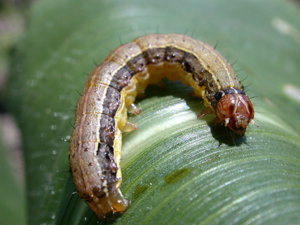

Although during the summer, the fall armyworm moth can fly pretty far throughout the eastern United States, they don’t much like the cold of the northern states. Therefore, they tend to congregate down south during the winter and can be found in Central and Southern Florida as well as Southern Texas.
These little creatures are actually the larvae of a moth. They have dark heads and brownish colored bodies with yellow and green stripes. If you look closely, you can see markings of an inverted Y on their forehead. While in this stage, they are voracious eaters and can cause a tremendous amount of damage to crops and outdoor plants.
They especially favor the green bermudagrass, but also like rye grass and fescue. They are attracted to almost all vegetable crops, as well as grain crops such as oats and wheat. When the weather is warm and the grass is cut short, they usually are seen early in the morning or in the evening as they will spend all day underground. However, if the grass is higher and the weather cooler, you may be able to spot them at any time during the day.
When they have had their fill of a yard, you can tell because you will see large round spots of grass that look as if they’ve died. These sections are usually brown or may even be described as burnt. It’s also been described as if someone accidentally sprayed grass killer in just one large spot.
Since they love to eat the leaves and foliage of crops, you can tell their presence in a crop field due to the stripped down stalks of corn or wheat. The damage to crops and grasses can sometimes appear to occur overnight. Because they are prey to birds, you can also sometimes tell if you have an armyworm problem because flocks of birds will settle in your yard to peck at the grass.
If you see signs of an armyworm problem, it’s important to get help right away before they do the most damage. Although it may take a few treatments, there are some effective options to take care of the problem. It takes a few treatments because armyworms have about a 35 to 60 day lifecycle from pupae to moth and you need to be able to target them at each stage.
The good news is that even if the grass looks dead, it really isn’t. It can recover with a little tender loving care on your part. After you’ve gotten rid of the armyworm problem, make sure to water and fertilize your yard and pretty soon you’ll see some pretty new grass shoots.
